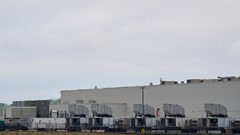The UK’s Clean Power Future Relies on a 100-Year-Old Technology
May 16, 2025 by Bloomberg(Bloomberg) -- Hidden amongst the picturesque lakes and mountains of North Wales lies Europe’s largest battery.
For years, water has rushed through Dinorwig’s subterranean tunnels to drive vast power turbines, but the channels currently lie empty — for the first time in four decades.
They’ve been drained for a £1 billion ($1.3 billion) refurbishment to extend the life of the plant along with a Welsh sister project in Ffestiniog, both vital to the UK grid. Their pumped-hydro technology is more than a century old, but at the moment is virtually the only way of storing electricity for longer than a few hours. It also provides crucial kinetic energy to the network, keeping the frequency stable.Hydro storage is a key partner to renewables generation in Britain’s Clean Power 2030 plan, and the country needs more of it.

“The site is really crucial to the UK’s renewable rollout,’’ said Miya Paolucci, UK chief executive at Engie SA, the utility that owns the site. “Refurbishing our existing plant should be a no-brainer.’’
The technology — largely based on gravity — is fairly simple: Water is pumped from a lower reservoir to a higher basin when energy is cheap and plentiful; then when power is lacking, it’s released back down and turns a turbine. That flexibility allows the operator to fill gaps in supply when the wind doesn’t blow or the sun doesn’t shine.
At Dinorwig, there is a 500-meter (1,640 feet) drop through the rock where the water comes smashing down to generate power. Some parts of the tunnels are big enough to fit a house inside.
The UK has about 3 gigawatts of long-duration energy storage and almost all of that is pumped hydro, according to data from the national system operator. To achieve a clean grid by the end of the decade, it says as much as 8 gigawatts will be needed. Dinorwig alone can generate 1.7 gigawatts.
Although the technology isn’t hugely complicated, no new projects have been built for decades due to the high upfront cost and the lack of financial incentives provided by the government, which instead has chaneled support toward solar and wind.



Pumped-hydro plants also only make sense in specific geographies — often mountainous areas where water can be pumped between high and low reservoirs.
Industry regulator Ofgem hopes to spur new projects by opening a so-called cap-and-floor funding program, which guarantees minimum revenues for developers and is due to kick in next year.
“The starting pistol has been fired,” Kate Gilmartin, chief executive officer of the British Hydropower Association, said in an interview. While the cap-and-floor details are yet to be determined, pumped hydro in Britain is “absolutely crucial, we need to have it online.”

The economics don’t work for everyone. Drax Group Plc put a pumped-hydro expansion plan on ice earlier this year, citing rising costs and uncertainty over the returns. Scotland’s SSE Plc is pursuing a 1.3-gigawatt project, but it’s yet to begin construction or secure all the necessary investment. The outline of the cap-and-floor mechanism right now doesn’t make Coire Glas investible yet, an SSE spokesperson said by email.
Ofgem’s funding will extend to other storage technologies such as flow batteries, which stash energy in liquid electrolytes, and liquid air systems, which liquefy and store air in insulated tanks. All these could help move the UK toward net zero goals. But pumped hydro, while expensive compared with solar and wind, is still among the lowest-cost of all long-duration storage, BloombergNEF data show.
The extensive refurbishment of the Dinorwig plant, by majority-owned by French utility Engie, will take as long as 10 years to complete and will mean the plant can run for an extra 25 years.
The plant has proved its worth in emergency situations. Inside the control room with its mix of analog and digital screens is a Green phone which comes with only one instruction: when it rings, you answer. This is the grid operator asking for a power boost as was needed in 2019 when more than a million customers in London lost supply.
“The advantage of pumped hydro is its durability,” the BHA’s Gilmartin said. “It is proven, it’s reliable, it’s been there for 120 years. So that kind of permanence gives us future resilience.”
©2025 Bloomberg L.P.
By


















